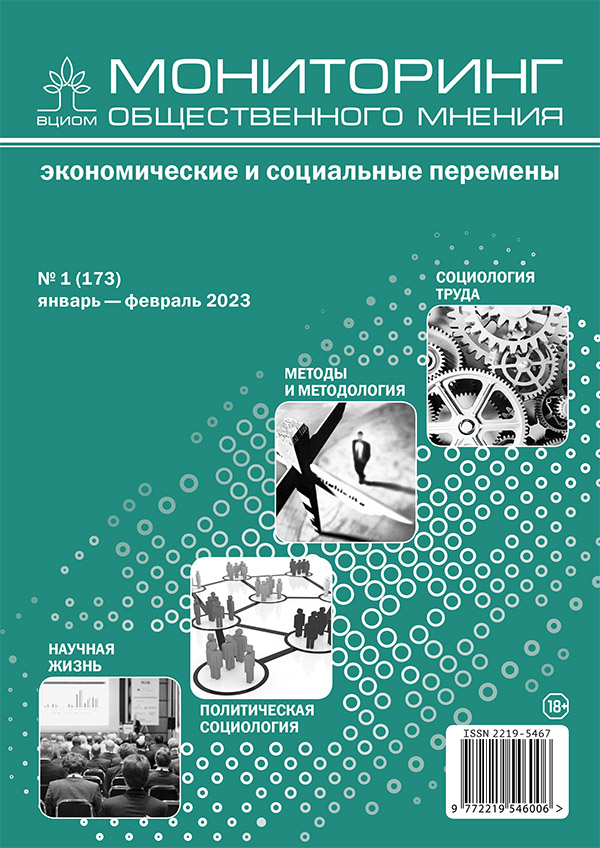Are weak social ties solid? Book Review: Centola D. (2022) How Behavior Spreads: The Science of Complex Contagions. Moscow: EKSMO. (In Russ.)
DOI:
https://doi.org/10.14515/monitoring.2023.1.2339Keywords:
Damon Centola, Mark Granovetter , Stanley Milgram, solid ties, weak ties, social networksAbstract
The author reviews the book of the American sociologist Damon Centola, who proceeds from the principle of evidence and proposes to rethink the dominant approaches to considering solid and weak social ties. Centola points out that the explanation proposed by Mark Granovetter follows the logic of simple contagion and is focused solely on performing the functions of rapid information and response. For an idea or social innovation to take root, complex contagion is required, which relies on strong social ties, where participants are closely connected and thus create redundancy in communication. In intergroup interaction, it is not the geographical coverage of the network that becomes important but the number of bridges between representatives of different communities. Centola emphasizes that solid connections are becoming a cornerstone of network sociology and management sociology since productivity increases significantly in close-knit groups with developed contacts.
Acknowledgments. The article was prepared with the financial support of the Russian Science Foundation (project No. 22-78-00082).
References
Баркер Дж. Опережающее мышление. Как увидеть новый тренд раньше других. М.: Альпина Паблишер, 2022.
Barker J.A. (2022) Paradigms. The Business of Discovering the Future. Moscow: Alpina Publisher. (In Russ.)
Гладуэлл М. Переломный момент. Как незначительные изменения приводят к глобальным переменам. М.: Альпина Паблишер, 2019.
Gladwell M. (2019) The Tipping Point: How Little Things Can Make a Big Difference. Moscow: Alpina Publisher. (In Russ.)
Грановеттер М. Сила слабых связей // Экономическая социология. 2009. Т. 10. № 4. С. 31—50.
Granovetter M.S. (2009) The Strength of Weak Ties. Economic Sociology. Vol. 10. No. 4. P. 31-50. (In Russ.)
Ефанов А.А. Деконструкция образа инфлюенсера в современном медиапространстве // Мониторинг общественного мнения: экономические и социальные перемены. 2021. № 5. С. 32—46. https://doi.org/10.14515/monitoring.2021.5.1958.
Yefanov A.A. (2021) Deconstruction of an Influencer Image in the Modern Media Space. Monitoring of Public Opinion: Economic and Social Changes. No. 5. P. 32—46. https://doi.org/10.14515/monitoring.2021.5.1958. (In Russ.)
Кун Т. Структура научных парадигм. М.: АСТ, 2020.
Kuhn T. (2020) The Structure of Scientific Revolutions. Moscow: AST. (In Russ.)
Лебон Г. Психология народов и масс. М.: ТЕРРА — Книжный клуб, 2008.
Le Bon G. (2008) The Crowd: A Study of the Popular Mind. Moscow: TERRA — Book Club. (In Russ.)
Реймонд М. Исследование трендов: практическое руководство. М.: МИФ, 2020.
Reymond M. (2020) The Trend Forecaster’s Handbook. Moscow: MIF. (In Russ.)
Тард Ж.Г. Законы подражания. М.: Академический проект, 2011.
Tarde G. (2011) The Laws of Imitation. Moscow: Academic Project. (In Russ.)
Тетлок Ф., Гарднер Д. Думай медленно — предсказывай точно. М.: АСТ, 2018.
Tetlock P.E., Gardner D. (2018) Superforecasting. The Art and Science of Prediction. Moscow: AST. (In Russ.)
Ушкин С.Г. «Народ против»: протесты и протестующие в виртуальных социальных сетях. М.: Инфра-М, 2018.
Ushkin S.G. (2018) «People Against»: Protests and Protesters in Virtual Social Networks. Mosсow: Infra-M. (In Russ.)
Чентола Д. Законы социального заражения: 7 стратегий изменения общественного мнения и поведения. М.: ЭКСМО, 2022.
Centola D. (2022) Change: How to Make Big Things Happen. Moscow: EKSMO. (In Russ.)
Barabasi A. (2003) Linked — How Everything Is Connected to Everything Else and What It Means for Business, Science, and Everyday Life. New York, NY: Plume Books.
Rogers E.M. (2003) Diffusion of Innovations. New York, NY: Free Press.
Travers J., Milgram S. (1969) An Experimental Study of the Small World Problem. Sociometry. Vol. 32. No. 4. P. 425—443. https://doi.org/10.2307/2786545.
Watts D.J., Strogatz S.H. (1998) Collective Dynamics of ‘Small-World’ Networks. Nature. Vol. 393. No. 6684. P. 440—442. https://doi.org/10.1038/30918.
Downloads
Published
How to Cite
Issue
Section
License
Copyright (c) 2023 Monitoring of Public Opinion: Economic and Social Changes Journal (Public Opinion Monitoring) ISSN 2219-5467

This work is licensed under a Creative Commons Attribution-NonCommercial-ShareAlike 4.0 International License.






